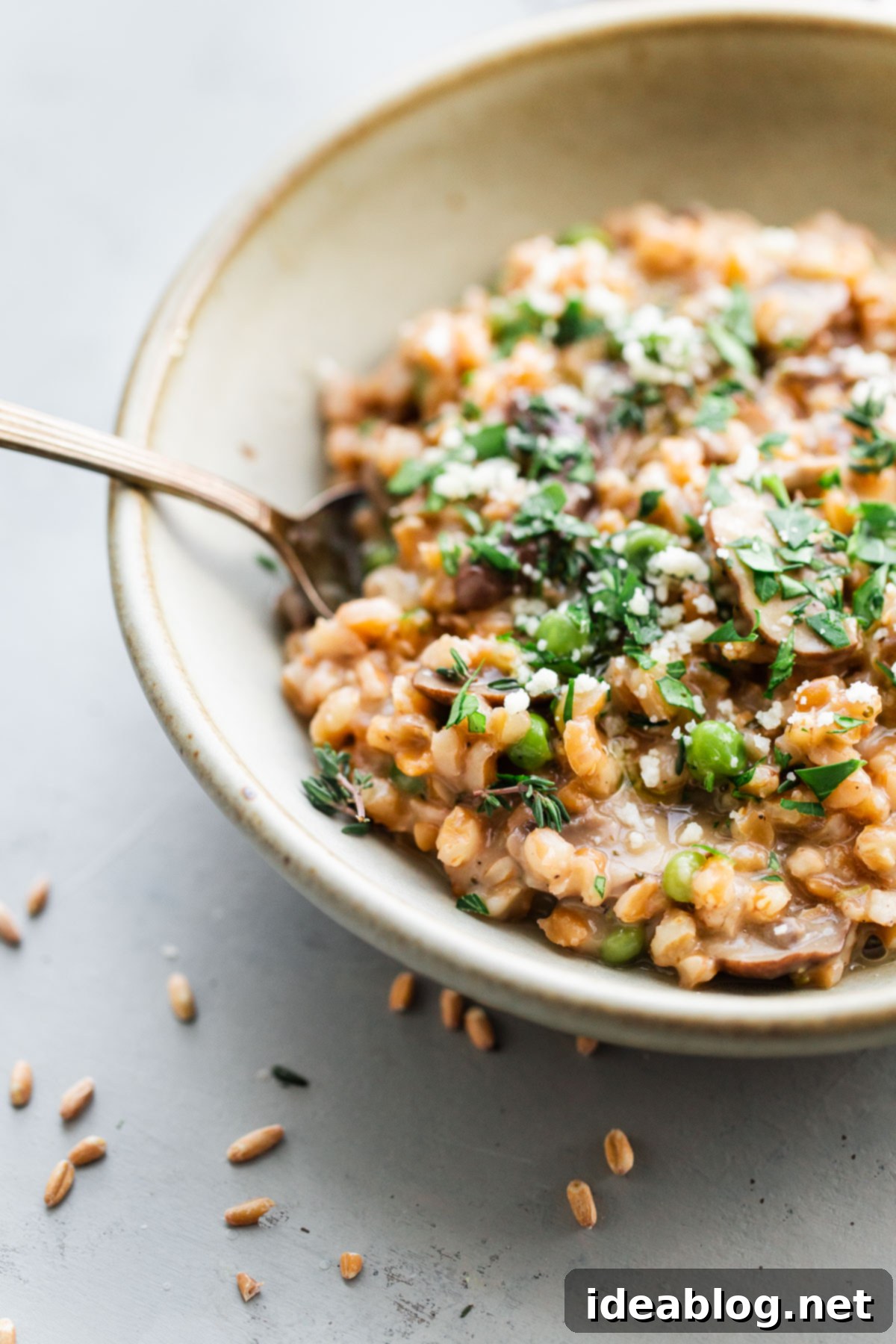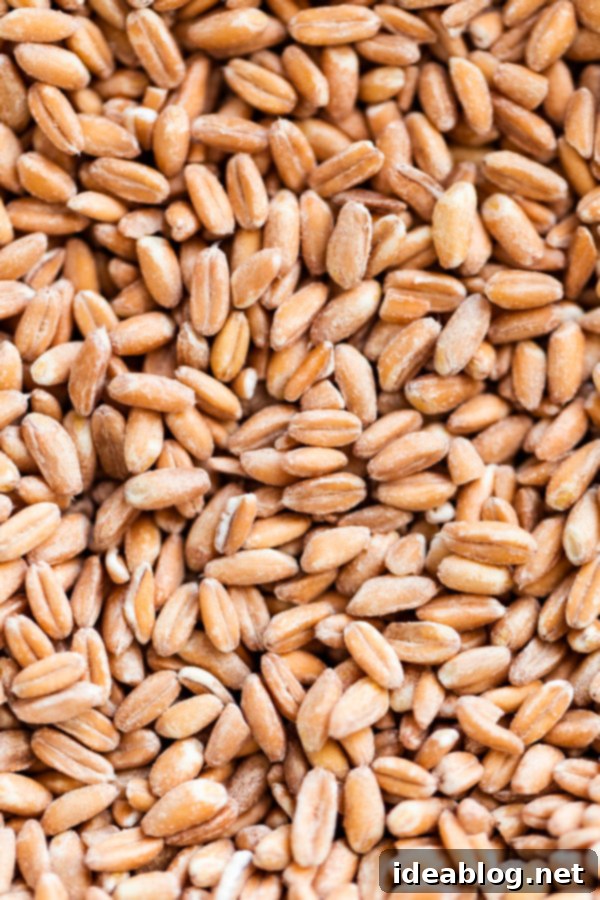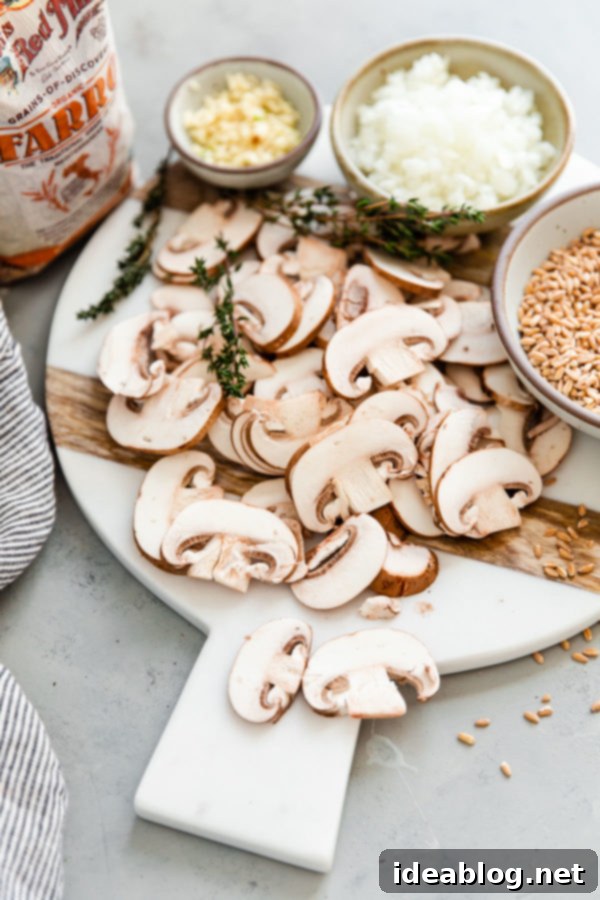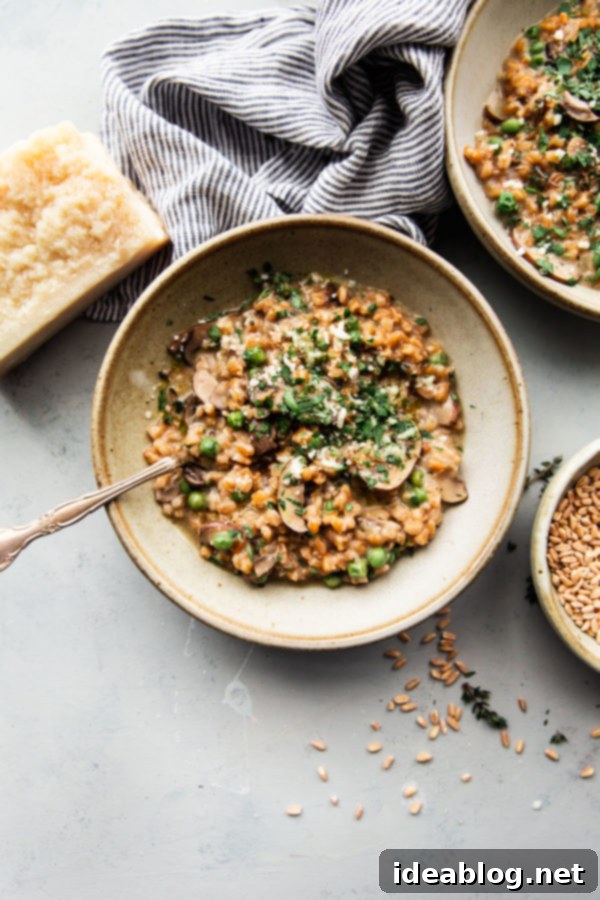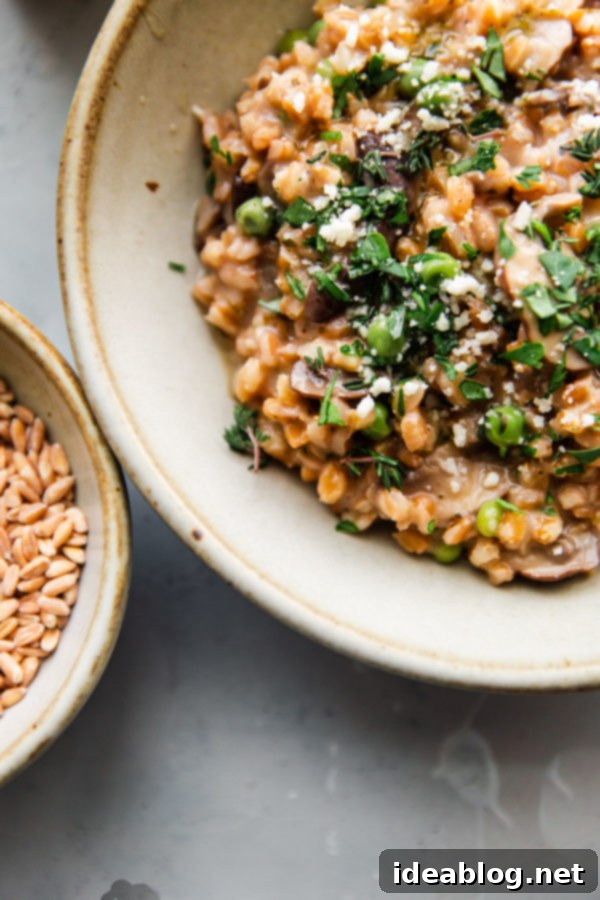Effortless & Healthy: Creamy No-Stir Mushroom Farro Risotto (Farrotto) Recipe
This mushroom farro risotto, affectionately known as farrotto, is a celebration of earthy mushroom flavor and vibrant fresh herbs, all brought together with my signature no-stir cooking method. It’s a hearty and healthier twist on a beloved Italian classic, perfect for any season.
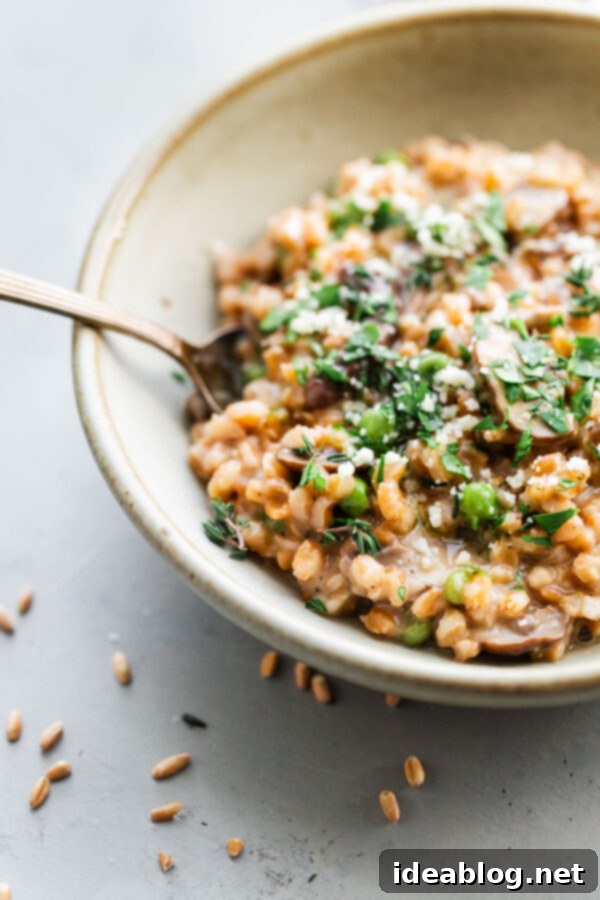
As the days grow shorter and the temperatures dip, there’s a natural longing for warm, comforting meals that nourish both body and soul. For those of us enduring chilly climates (hello, Midwest!), a truly satisfying dinner can make all the difference. This Mushroom Farro Risotto is precisely that – a cozy, healthier dish designed to bring warmth and flavor to your table on even the darkest, coldest evenings. (And if you’re basking in year-round sunshine, consider this a delicious invitation to experience comfort food at its finest!)
Nothing evokes a sense of comfort quite like a bubbling pot of risotto. As someone with an appreciation for Italian cuisine, traditional risotto holds a special place in my heart. However, I’ve found myself falling even more deeply in love with farro risotto – or “farrotto,” as it’s often called. This wholesome grain offers a truly unique experience that elevates the classic dish.
Farro risotto stands out for many reasons: it’s incredibly hearty, packed with more nutrients than its rice-based counterpart, and remarkably forgiving in the kitchen. Its distinct chewy texture is something I simply can’t get enough of, adding a delightful dimension to every bite. It’s a dish that satisfies deeply, leaving you feeling nourished and content.
This particular mushroom farro risotto recipe is designed for maximum flavor and minimal fuss. It’s wonderfully creamy, intensely flavored with earthy mushrooms and fragrant fresh herbs, and utilizes my absolute favorite no-stir cooking method. Mushrooms are a year-round staple for me, but their rich, umami-packed flavor truly shines during the colder months, providing a “meaty” satisfaction in vegetarian dishes. To add a vibrant pop of color and a touch of natural sweetness, we’ll stir in some thawed frozen peas just before serving. This not only enhances the visual appeal but also complements the robust flavors of the mushrooms and farro beautifully.
I’m thrilled to partner once again with my long-standing friends at Bob’s Red Mill for this recipe. They are renowned for producing exceptional organic farro, which is key to achieving the perfect texture and flavor in this dish. If you’re new to this incredible ancient grain, don’t worry – I’ll cover all the essentials below, including what farro is, what makes Bob’s Red Mill farro superior, and straightforward instructions on how to prepare it to perfection.
Whether you’re a seasoned cook or just beginning your culinary journey, if you haven’t yet experienced the magic of farro risotto (or even classic risotto!), I wholeheartedly encourage you to give this recipe a try. It’s an undeniable winner that promises a delightful meal with significantly less active cooking time. For an even clearer guide, be sure to watch the accompanying recipe video!
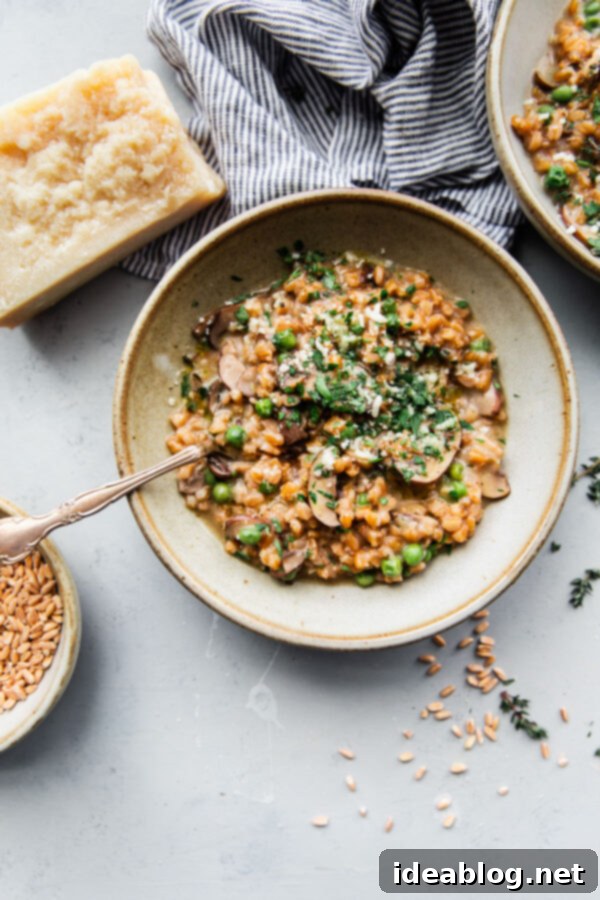
What Is Farro? An Ancient Grain Explained
While many people mistakenly believe farro is a singular strain of grain, the truth is a bit more nuanced. Farro is actually an Italian term that translates to “ancient hulled wheat grain,” encompassing several varieties of wheat. It proudly belongs to the category of “ancient grains,” a loose classification for grains that have remained largely unchanged for thousands of years, preserving their original genetic makeup and robust nutritional profiles.
Historically, farro was a fundamental staple in ancient Roman diets, highly valued for its impressive nutritional content and ability to provide sustained energy. Today, it remains a cherished ingredient in traditional Italian cooking, adding depth and a distinctive chewiness to countless dishes. Farro can originate from one of three wheat varieties: spelt, emmer, or einkorn. It’s important to note for those with dietary restrictions that since farro is a wheat product, it is not gluten-free.
Beyond its ancient lineage and historical significance, farro boasts an excellent nutritional profile. A mere 1/2 cup of cooked farro (which comes from 1/4 cup dry) provides a substantial 7 grams of dietary fiber and 7 grams of protein, making it incredibly filling and beneficial for digestive health. Additionally, it’s a good source of essential minerals like potassium and iron, contributing to overall well-being.
Once cooked, farro develops a fantastic chewy texture – often compared to wheat berries or even barley – and a subtly nutty flavor. Its inherently hearty and satisfying nature makes it incredibly versatile in the kitchen. It can be effortlessly incorporated into, or substituted for other grains in, a wide array of recipes. Think vibrant salads, comforting soups and stews, nutritious side dishes, and hearty casseroles. I even enjoy transforming it into a delicious and wholesome farro porridge for breakfast!
Why Bob’s Red Mill Organic Farro is My Top Choice
When it comes to selecting the best farro for your kitchen, quality truly makes a difference. The most widely available type of farro, and the one I consistently recommend, is spelt-based, often labeled as ‘farro grande’ or Triticum spelta. This is precisely what you’ll find in Bob’s Red Mill Organic Farro. What sets Bob’s Red Mill apart from other brands on the market, and why is it my preferred choice for this farrotto recipe?
Unlike some whole farro varieties, Bob’s Red Mill gently scores their farro grains. If you look closely, you’ll notice delicate cuts on each grain. This light scoring process means a very small portion of the bran is removed. Consequently, it is technically not classified as a “whole grain” in the strictest sense. However, this intentional processing offers significant advantages without compromising the nutritional integrity.
The beauty of this light scoring is that it preserves the vast majority of the grain’s nutritional content while simultaneously reducing its cook time. More importantly for a dish like risotto, it greatly promotes starch release. This enhanced starch release is crucial for developing that wonderfully thick, creamy texture we crave in a risotto. This unique characteristic makes Bob’s Red Mill farro an unparalleled choice, whether you’re using it as a hearty substitute for rice in various dishes or specifically crafting a homemade farro risotto. Its consistent quality and performance are why it remains a staple in my pantry and the foundation for this delicious recipe.
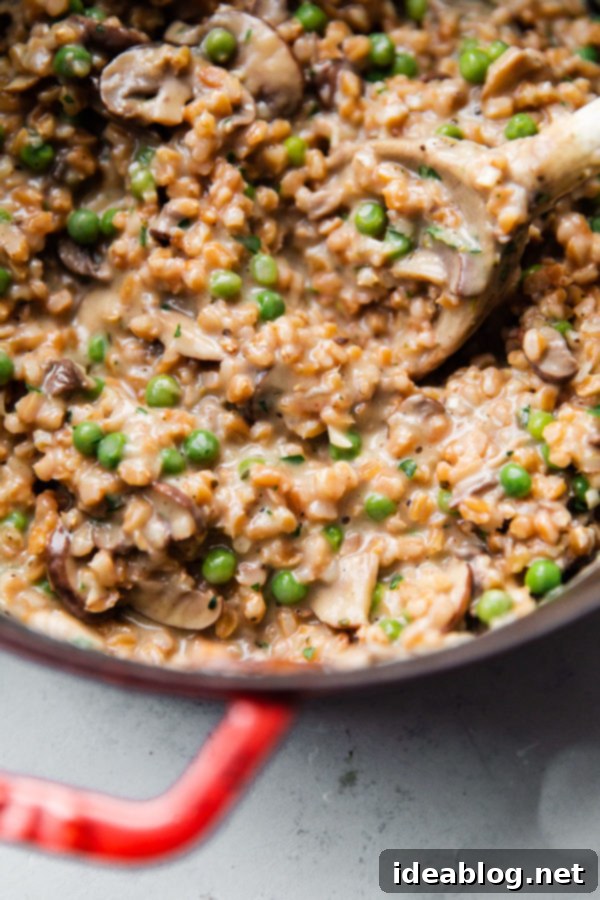
Mastering Farro Risotto: The Easy No-Stir Method
For many culinary enthusiasts, traditional Italian risotto, typically made with arborio or carnaroli rice, is celebrated for its luxurious, creamy texture. These specific Italian white rice varieties are prized for their high starch content, which is meticulously coaxed out during the cooking process to create that signature velvety consistency. The classic method involves first sautéing aromatics, then lightly toasting the rice grains, deglazing the pan with white wine, and finally, adding hot broth in small batches. Each addition of broth is stirred continuously until fully absorbed before the next is added. This labor-intensive, hands-on technique ensures the starches release gradually and that the rice cooks perfectly to an al dente bite. While the technique itself isn’t overly complicated, it demands constant attention and stirring, making it quite time-consuming.
Farro risotto, affectionately known as farrotto, offers a delightful and healthier spin on this Italian classic. Instead of rice, it uses farro, which, while taking a bit longer to cook, yields a heartier and wonderfully chewier texture. This makes it a more nutritious and wholesome alternative that doesn’t sacrifice an ounce of flavor or satisfaction. While it definitely presents a different mouthfeel compared to traditional risotto, I find farrotto equally, if not more, satisfying. Its substantial nature leaves me feeling fuller for longer, and a significant bonus is that leftovers tend to hold up much better than rice-based risotto.
And here’s the best part: with my innovative no-stir method, making farrotto becomes incredibly simple. Think about that for a moment – a healthier, deeply satisfying risotto, made easy! This simplified approach opens up the world of comforting Italian-inspired meals to even the busiest weeknights.
The Secret to Easy Farrotto: My No-Stir Method
Traditional risotto relies heavily on constant stirring to achieve its signature creaminess. However, farro behaves differently from Arborio rice, and it doesn’t require the same continuous attention to release its starches effectively. This is where my favorite no-stir method shines, making this recipe truly distinct and remarkably user-friendly.
Instead of gradually adding broth, this technique involves adding almost all of the cooking liquid at once. The farro then simmers slowly, allowing the grains to cook gently and evenly while still releasing enough starch to create a thick, creamy sauce. You’ll only need to stir once or twice throughout the entire cooking process – a stark contrast to the continuous stirring required for traditional risotto. While this mushroom farro risotto might take about an hour from start to finish, your active cooking time is drastically reduced to only about 15 minutes. This frees you up to focus on other tasks, making it an ideal candidate for busy weeknight dinners. Serve it alongside a fresh green salad, and you’ve got a complete, wholesome, and delicious one-pot meal on the table with minimal effort.
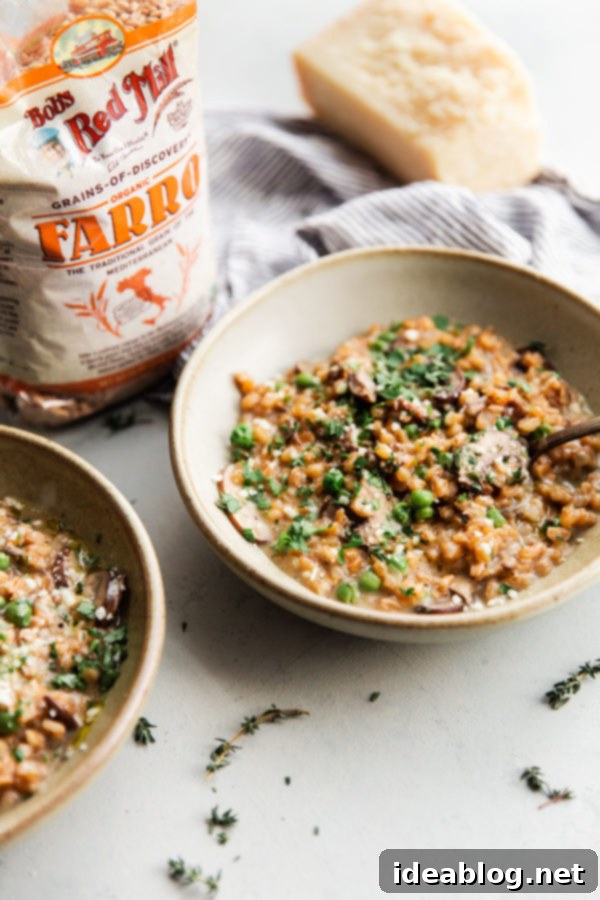
Essential Tips for Mushroom Farro Risotto Success: Elevating Your Farrotto Experience
Achieving the perfect, creamy, and flavorful mushroom farro risotto is simpler than you might think, especially with a few key tips to guide you. Follow these suggestions to ensure your farrotto turns out delicious every time:
- Mushroom Selection for Optimal Flavor: To make this recipe broadly accessible, I’ve opted to exclusively use readily available cremini mushrooms, also known as baby bellas, which you can find at any standard grocery store. These mushrooms offer a robust, earthy flavor that beautifully complements the farro. However, for an even deeper and more complex flavor profile, consider experimenting with a combination of wild mushrooms (such as shiitake, oyster, or chanterelle) or incorporating dried porcini mushrooms, rehydrated and finely chopped, into your mix. Porcinis, in particular, lend an intense umami boost that will truly elevate your dish.
- Don’t Skimp on the Parmigiano-Reggiano: This ingredient is non-negotiable for achieving that authentic Italian depth of flavor and luscious creaminess. The recipe calls for stirring in a generous 3/4 cup of freshly grated Parmigiano-Reggiano cheese once the farro has reached its ideal tender-chewy consistency. This isn’t just for taste; the cheese’s fat and emulsifying properties are critical for forming the rich, smooth texture of the risotto. Using pre-grated cheese is fine, but for the absolute best flavor and melt, grate a fresh block yourself.
- The Crucial Resting Period: This might seem like a small step, but it makes a significant difference. After you’ve stirred in the final ingredients and removed the pot from the heat, cover it and allow the farrotto to rest undisturbed for approximately 5 minutes before serving. This brief resting period allows the flavors to meld, the farro to continue releasing starches, and the overall dish to thicken and become even creamier. In my experience, this yields a noticeably improved texture that more closely resembles the luxurious consistency of classic rice-based risotto.
- Taste and Adjust Seasoning: Never underestimate the power of proper seasoning. Farro and mushrooms are naturally savory, but they truly sing with the right amount of salt and pepper. Taste your farrotto before serving and don’t be afraid to add another generous pinch or two of kosher salt if it tastes “flat.” A dash of freshly ground black pepper also adds a subtle warmth and complexity.
- Warm Your Serving Bowls: For the ultimate dining experience, serve your farrotto in pre-warmed bowls. Risotto is best enjoyed hot, and a warm bowl will help maintain its temperature and creamy consistency for longer, ensuring every bite is as comforting as the first.
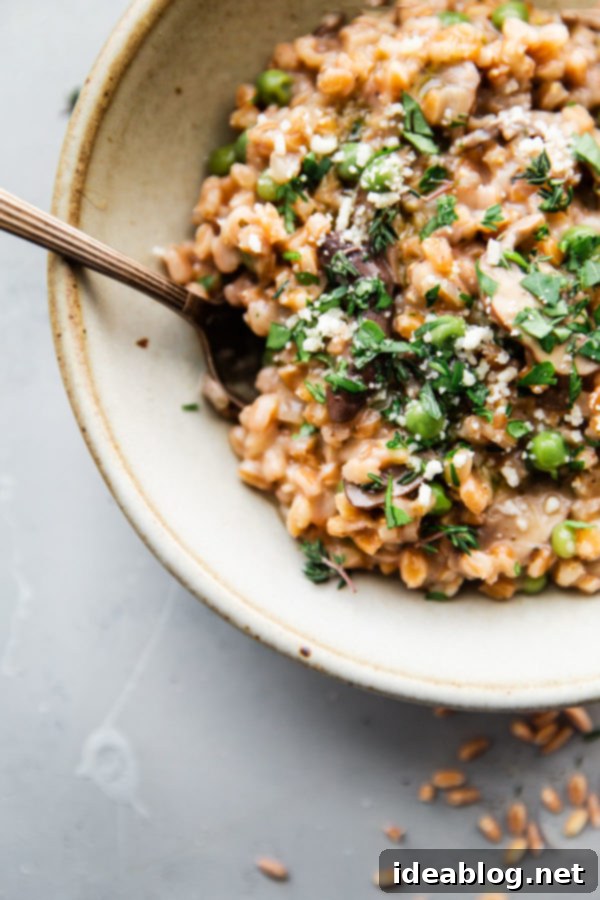
Explore More Farro-tastic Recipes
Once you fall in love with farro, you’ll want to incorporate this versatile ancient grain into more of your meals. Here are a handful of my other favorite recipes that highlight the incredible qualities of farro, or can easily be adapted to include it:
- Strawberry Caprese Farro Salad: A refreshing and vibrant salad that uses farro for a satisfying base.
- Broken Farro Porridge: A wholesome and comforting breakfast option, proving farro isn’t just for savory dishes.
- Asparagus Salad: Easily adapt this recipe by using farro in place of wheat berries for a similar nutty flavor and chewy texture.
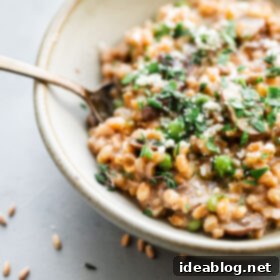
Easy Mushroom Farro Risotto
Pin
Review
SaveSaved!
Equipment
-
Staub 5.5 Quart Round Cocotte
-
Imagine Organic Low-Sodium Chicken Broth
Ingredients
- 4 cups (1 quart) low sodium chicken broth
- 3 tablespoons unsalted butter
- ½ large yellow onion finely chopped (roughly 1 cup)
- kosher salt
- freshly ground black pepper
- 12 oz cremini (Baby Bella) mushrooms cleaned, trimmed, and thinly sliced
- 3 large garlic cloves finely chopped
- 1 tablespoon finely chopped fresh thyme plus more for garnishing
- 1½ cups Bob’s Red Mill Organic Farro
- ¾ cup dry white wine such as Pinot Grigio
- parmigiano-reggiano cheese rind optional
- ¾ cup grated parmigiano-reggiano cheese plus more for serving
- 1 teaspoon freshly squeezed lemon juice
- ¾ cup frozen peas thawed
- flat leaf parsley finely chopped, for garnishing
Instructions
-
Place the chicken broth in medium saucepan and bring to a low simmer. Keep over very low heat.
-
In a large Dutch oven (or heavy-bottomed pot), heat the butter over medium heat until melted and lightly bubbling. Add the onion, along with a generous sprinkle of kosher salt, and sauté over medium-low heat for 5 to 7 minutes, stirring often, until the onion is soft and translucent.
-
Increase the heat to high. Add the sliced mushrooms and stir to combine. After a minute or so, the mushrooms will begin to sweat and release their moisture, intensifying their flavor. Continue cooking for an additional 2 to 3 minutes, stirring occasionally, until the mushrooms have softened and lightly browned. Add the garlic and fresh thyme and sauté, stirring continuously, for 30 seconds or until wonderfully fragrant. Season generously to taste with salt and pepper.
-
Add the farro to the pot and toast over medium-high heat for 1 to 2 minutes, stirring continuously. This step helps to bring out the nutty flavor of the farro and prepares it for liquid absorption. The farro will crackle lightly, and the pan should be mostly dry.
-
Add the dry white wine to deglaze the pan, stirring every so often until the wine has been completely absorbed, typically 2 to 3 minutes. Then, add the optional parmigiano-reggiano rind (which infuses incredible umami and depth) and all of the hot broth to the pot. Stir everything to combine thoroughly and bring the mixture to a boil. Once boiling, reduce the heat to a steady, gentle simmer, cover the pot, and cook for 45 to 50 minutes. Stir the farrotto every 15 minutes or so to prevent sticking and promote even cooking. Continue until the farro is tender, yet still pleasantly chewy in the center, and the risotto has thickened to a creamy consistency.
Note: For optimal thickening and easier texture monitoring, I recommend removing the lid during the final 5 to 10 minutes of cooking. If you notice a significant amount of liquid remaining, you can slightly increase the heat during this uncovered period to reduce it to your desired consistency.
-
Over very low heat (or with the heat off), stir in the grated parmigiano-reggiano cheese and freshly squeezed lemon juice until well combined and creamy. Gently fold in the thawed peas. Taste the farrotto and season generously with kosher salt and freshly ground pepper as needed. A common mistake is under-seasoning; if the dish tastes somewhat bland or “flat,” a little more salt will likely bring out all the beautiful flavors.
-
Remove the pot from the heat completely, cover it tightly, and allow the farrotto to rest for 5 minutes before serving. This essential extra step allows the remaining starches to fully release, further thickening the dish and creating an even more luxurious, classic risotto-like texture. Don’t forget to remove and discard the parmigiano-reggiano rind before serving, if you used one.
-
Serve the warm, inviting farrotto in pre-warmed bowls to maintain its ideal temperature. Garnish generously with additional fresh thyme leaves, finely chopped flat leaf parsley, and extra freshly grated parmigiano-reggiano cheese, as desired, for an extra burst of flavor and a beautiful presentation.
Video
